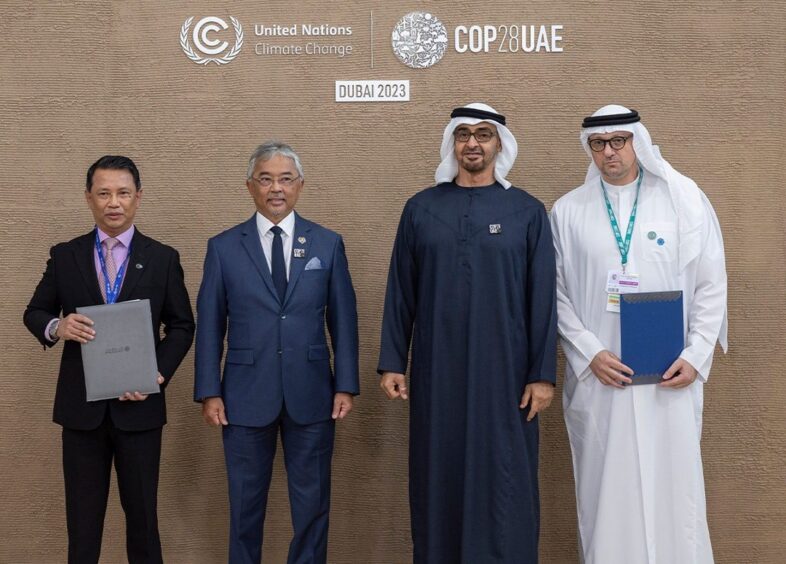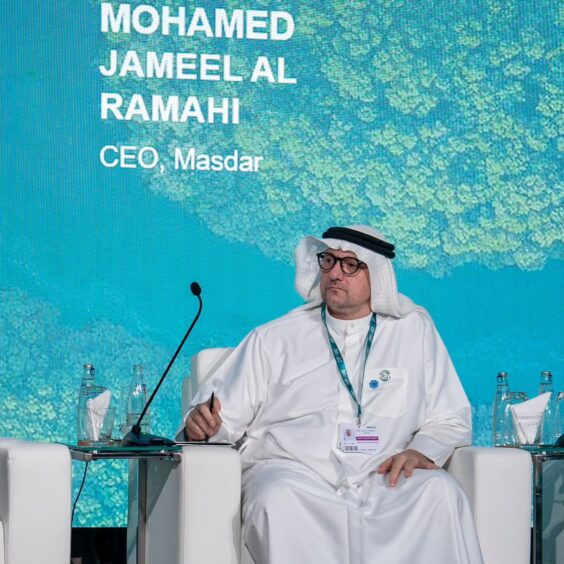
Abu Dhabi’s state-backed Masdar has signed a slew of deals at COP28, in Kyrgyzstan, Kazakhstan and Poland, in addition to forays into Asia and Africa.
Masdar struck a deal with RWE to invest in the 3 GW Dogger Bank South project. As such, it has struck agreements that – if expectations are met – could provide nearly 20 GW of clean energy.
Malaysia, Indonesia
The broadest move was an agreement to develop 10 GW of clean energy projects in Malaysia. Masdar signed the roadmap deal with the Malaysian Investment Development Authority, in a signing witnessed by the heads of both countries.
Masdar’s Malaysian plan covers ground mounted, rooftop and floating solar power, in addition to onshore wind farms and battery energy storage systems. Masdar CEO Mohamed Jameel Al Ramahi agreed the deal with MIDA CEO Datuk Wira Arham Abdul Rahman. The statement noted that the deal paved the way for five more agreements covering solar and wind in Malaysia.
Masdar shed some light on the specifics. It said there was a joint agreement for 2 GW of solar with Citaglobal Berhad & Tiza Global in Malaysia. Masdar also agreed to work with Tadau Energy and PSK on a similar amount of wind capacity.
It reached a memorandum of understanding (MoU) with Cypark Resources Berhad for up to 1 GW and a heads of agreement with Malakoff, for up to 1 GW of solar.
Masdar also signed up to work with Indonesia’s PLN utility on floating solar power and green hydrogen. The two companies have already launched Southeast Asia’s largest floating solar facility, the 145 MW Cirata.
The agreement at COP28 saw them agree to study the tripling of Cirata’s capacity to 500 MW.
“With its robust economy and abundant renewable resources, Southeast Asia is a key investment destination for Masdar,” said Al Ramahi. “Through our deepening cooperation with PLN, we will continue pioneering innovation in solar, green hydrogen and other key areas in support of the region’s energy transition.”
Kazakhstan, Kyrgyzstan
The Kyrgyzstan and Kazakhstan agreements followed a similar model of high-ranking political support.
Kazakshtan President Kassym-Jomart Tokayev oversaw the signing of a 1 GW wind power project on December 2.
The work involves Masdar and various Kazakh agencies such as sovereign wealth fund Samruk-Kazyna and the Kazakhstan Investment Development Fund.
The next day, Masdar signed up with EDF to agree on developing 3.6 GW of capacity in Kyrgyzstan. This marks the entry of Masdar into hydropower.
Kyrgyzstan President Sadyr Japarov oversaw the signing.
Masdar head Al Ramahi said the agreement marked a “new chapter for Masdar in our clean energy journey … we are glad to have the opportunity to bring the energy, passion and focus to hydropower that we have utilised for so many other renewable energy sources”.
Poland
Masdar continued its streak of signings on December 4, lining up to acquire eight renewable energy projects in Poland, alongside Finland’s Taaleri Energia. They bought the 1 GW of assets from a Polish developer, Domrel.
The Abu Dhabi company said the projects were hybrid solar PV and wind. This allows it to capitalise on recent amendments to the Polish Energy Law. This allows companies to link various renewable energy sources via a single grid connection.
These amendments came into force in October this year and may add as much as 25 GW of renewable capacity in Poland.
Angola
Masdar also announced it would develop a 150 MW solar PV plant in Angola. It plans to build this in the southern Hulia province.
The project would help Angola tackle its electrification challenge. The West African state aims to secure electricity access for 60% of its population by 2025.
Masdar chairman – and COP28 president and head of Adnoc – Sultan Al Jaber oversaw the Angolan signing.
“Africa has what it takes to become the world’s renewable energy powerhouse. At COP28 and beyond, we will continue to work with Africa for Africa,” he said. “We look forward to developing this strong partnership with Angola as we work together to maximise the country’s huge clean energy potential.”
Masdar has projects in more than 40 countries, with total capacity of more than 20 GW. It aims to reach 100 GW, and 1 million tonnes per year of green hydrogen, by 2030.
The company also aims to produce 10 GW of clean energy in Africa by 2030. At the start of this year, Masdar set out plans to build 5 GW of power in Angola, Zambia and Uganda.

 © Supplied by Masdar
© Supplied by Masdar